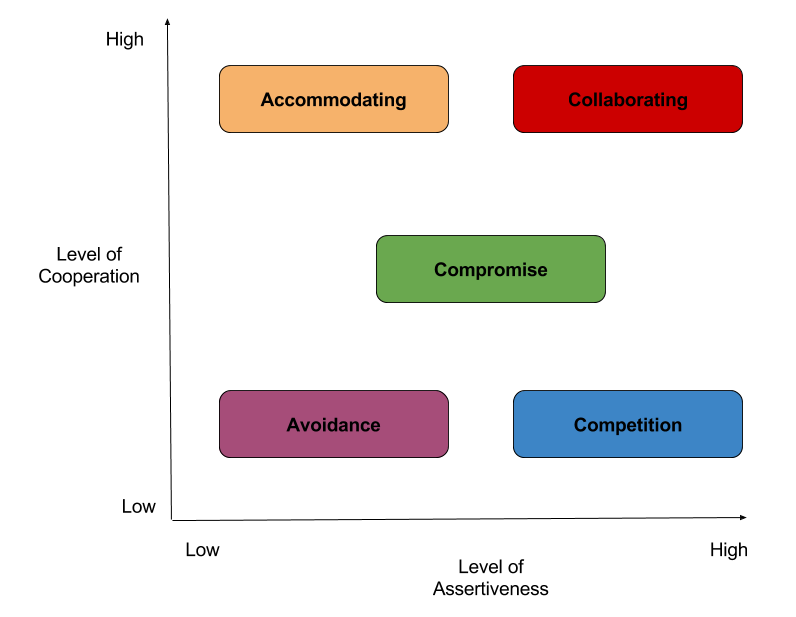Teams and Collaboration
Stress and Conflict Management
MINDS ON
 Substantive vs Emotional Conflicts
Substantive vs Emotional Conflicts
Think about potential conflict in the workplace, and what might be the difference between Substantive Conflicts and Emotional Conflicts.
You may want to do some quick research, or look up definitions to these terms on your own before responding. Identify the difference between each term and add your own personal thoughts about each in your portfolio.
 Conflict: Good or Bad?
Conflict: Good or Bad?
Answer the following questions.
- Is all conflict negative or bad? Can conflict be positive?
- Provide an organizational or workplace example when conflict could be positive. Explain.
ACTION
Conflict
Conflict is simply disagreements between people based on two types of issues: substantive or affective issues.
Substantive conflicts deal with disagreements or arguments regarding tasks, goals, job assignments, how to allocate resources, or really any other issues with regard to the team’s actual work and work processes.
Affective conflict, also known as emotional conflict, has to do with disagreements resulting from individual feelings - anger, dislike, distrust, resentment, fear, etc. This is generally the result of interpersonal issues among team members.
In either case, managers and team leaders often spend considerable time dealing with conflict of many forms in the workplace. Both forms of conflict can cause problems in an organization and lead it into situations where goals and objectives may not be met. These conflicts can also cause employees and teams to be less productive.
In additional to conflict, stress and stressors can interfere with employee and team performance, productivity, and the ability of organizations to reach goals. Stress is also a natural part of life. Stress is simply the reactions we have to the pressures of everyday life (stressors). Our bodies and minds respond to threats and pressures in different ways. Stress can cause mental and emotional anguish, and can lead to health issues if left unchecked. Recognizing and responding to stress, while managing and limiting the amount of stress in our personal and professional lives is quite important.
Conflict and Stress in the Workplace
What are the potential causes of conflict and stress in the workplace? The answers to this question are many and far-reaching, but some of the most common sources of conflict in the workplace are:
- working conditions,
- difficult personalities, and
- restructuring.
Working Conditions
The day-to-day working conditions of employees and teams have a huge impact on their attitudes, feelings, and performance. If a working condition is perceived to be poor, it can create conflict between an employee and management within the organization. An example of this might be a scarcity of resources. If employees and teams have to share resources with others, and essentially compete for the tools and things that are required to perform their daily job duties, conflict can arise.
An additional example might be ambiguities in work roles and responsibilities. Uncertain or unclear job responsibilities can create friction and tensions in the workplace, especially when organizational duties or tasks are not being performed. This creates conflict.
Yet another example might be when employees just feel unappreciated by managers and the organization. Perhaps a dedicated employee area where all employees can eat lunch uninterrupted, or take a 15-minute break, has not been provided. This might create a feeling of animosity and disappreciation among employees, and cause negative feelings toward management and the organization in general. This can cause conflict.
Difficult Personalities
One of the most common sources of conflict in the workplace revolves around personal disagreements and tensions. Different people have different viewpoints, different backgrounds and experiences, and different attitudes. It is often a great challenge in meshing these differences when working on a team. It often requires give and take, and coming to some reasonable consensus in order to meet objectives and outcomes.
Managing and dealing with difficult personalities in the workplace can be challenging, and often requires a very diplomatic approach. Watch the following video to learn more about strategies to deal with high-conflict personalities.
Think About It...
Have you ever had to deal with a difficult personality at some point in your life? How did you deal with that person? What did you do?
Restructuring
Restructuring is something that happens on a regular basis within businesses and organizations. It is quite simply a change or reorganization of workflows, processes, teams, departments, or any other workplace process. In order to stay competitive, change is usually required, but unfortunately it is a common source of conflict in the workplace. Imagine working in a department with a team of employees for 10 years, only to have your current manager completely change job titles and responsibilities, as well as, work flows and outcomes. This can realistically create tension and conflict between employees, teams and management.
Think About It...
Has some element of restructuring or change ever had an affect on your life? Did it cause some sort of conflict? How did you deal with it?
We have briefly examined some of the most common sources of conflict within organizations, but can you think of any others?
 Sources of Conflict in the Workplace
Sources of Conflict in the Workplace
What are other potential sources of conflict in the workplace?
Managing Conflict in the Workplace
There are two major ways in which people respond to workplace conflict - through cooperation or through assertion. Cooperation involves one person’s desire to satisfy the other’s needs or concerns. Assertion, or assertiveness, involves one person’s desire to satisfy their own individual needs or concerns. Five typical workplace conflict management styles result from varying levels of cooperation and assertiveness:
- Avoidance
- Accommodation
- Competition
- Compromise
- Collaboration

Avoidance - Sometimes referred to as withdrawal, avoidance is simply being uncooperative and unassertive. This really means just doing nothing and attempting to avoid a conflict in the hopes that it will just go away.
Think About It...
Think of a time when you have avoided a conflict.
Accommodation - This conflict management style is about being cooperative, but not assertive. It is sometimes called smoothing. The goal here is to achieve harmony while not creating any further conflict.
Think About It...
Think of a time when you have accommodated a conflict.
Competition - Competition is often referred to as authoritative command. This is a situation where one is highly assertive but does not cooperate. The person generally works against the wishes, views, and perspectives of others and does what they feel is best. Often times a solution is pushed through just based on authority.
Think About It...
Think of a time when you may have used competition in a conflict situation.
Compromise - This is a middle-of-the-road approach. A moderate level of both cooperation and assertiveness is used to come to a healthy compromise. This is where give and take occurs on behalf of all parties involved in the conflict. Sometimes, this means giving up something, and potentially gaining something.
Think About It...
Think of a time when you may have used compromise in a conflict situation.
Collaboration - Collaboration is sometimes called or referred to as a problem-solving approach. Here we have a high level of cooperation, and a high level of assertiveness. This conflict management approach attempts to come to the very best possible resolution - trying to satisfy everyone’s concerns and issues by really working through differences. The attempt is to truly solve the problem so that everyone experiences a win.
Think About It...
Think of a time when you may have used collaboration in a conflict situation.
Check Your Understanding
Work through the following activity to review your understanding of the five conflict management styles. Match each statement to the correct conflict management style.
Conflict
Restorative Justice
A way of managing and dealing with conflict that is growing in its widespread usage is something called restorative justice. It is an approach that attempts to bring restitution to victims of conflict and crime, in a more personal, respectful and individual healing environment. The attempt is to simply not punish, but bring healing to all involved, and allow everyone involved in, and affected by the conflict, to grow and change.
Watch a brief introduction to the idea of restorative justice.
One of the main goals of restorative justice is to engage in a mediated dialogue and conversation. This is often referred to as dialogue circles as all participants form a circle so that everyone is included, everyone can be seen, and all voices are heard in a respectful and caring atmosphere.
 Restorative Justice
Restorative Justice
Share your responses to the following questions in the discussion.
- Do you think restorative justice and dialogue circles can be effective at resolving conflict in your daily life? Why or why not? Explain your answer.
- Can restorative justice and dialogue circles be realistically helpful in solving and managing conflict within organizations? Why or why not? Would you use this strategy as a manager? Explain.
 You Be The Boss!
You Be The Boss!
Take a look at the following conflict scenarios. Source. Your goal is to analyse the situation and explain how you would handle the problem in order to resolve the conflict that exists. Remember that you are acting as the manager in the scenario. Explain the conflict management style(s) that you think would work best.
Record your solution to the problem and make sure you identify the potential conflict management strategy you will use.
 Managing Stress in the Workplace
Managing Stress in the Workplace
Think about times you have felt stress caused by some sort of stressor in the past. This might have been a big unit test, a final exam, a job interview, trying out for a sports team, or maybe a personal conflict with someone. How did you deal with that stress, and what did you do to attempt to reduce the amount of stress you experienced?
As a Manager, would you be able to identify when one of your employees was under a great deal of stress? What are the signs of stress? How can stress affect an employee's performance on the job?
Stress Management - Stress Reduction Techniques
Effective leaders and managers must be fully aware of the potential signs of stress in employees. They must work hard to alleviate stress and ensure that techniques and strategies are in place to help people who are under too much stress. An employee who is under a great deal of personal or workplace stress is more apt to get sick, take leave time, and really experience a drop in performance and productivity. It is in the best interest of the organization to be proactive in dealing with stress.
Let’s examine some of the more common workplace stress reduction techniques.
1. Wellness Programs
Many very successful organizations have come to the conclusion that supporting their staff and keeping them healthy contributes to more productive workforces. Organizations now provide wellness programs in order to to do this - not only to reduce stress, but to keep employees healthier. A healthy employee is not sick as often, takes fewer days off, is less stressed, and is generally more productive. Elements of employee wellness programs might include:
| Gym memberships | Professional activity days | Programs to help stop smoking | Drug and alcohol dependence assistance |
| Weight management programs and assistance | Access to doctors and other health professionals in the workplace | Physical training equipment at work | Stress reduction training |
| Employee meal program | Ride your bicycle to work days and incentives | Breathing exercise training | Nutrition advice and mentorship |
| Massage services | Conflict resolution training | Fitness subsidies | Art therapy |
| Transit passes | Counselling services | Yoga classes |
2. Meditation and Breathing Exercises
Meditation is a common technique used to ease stress and create a sense of calmness.
Take the next 11 minutes to experience the use of meditation to help reduce stress. If you cannot commit an uninterrupted 11 minutes now, you might want to come back to this video later. The best approach is to position yourself in a quiet space where you can lie down while listening to the video audio.
In addition to meditation, another commonly associated technique for reducing stress is simple breathing exercises. Learn three (3) appropriate stress reduction, or anxiety relief breathing strategies.
 Meditation and Breathing Reflection
Meditation and Breathing Reflection
After you experienced both the guided meditation and breathing exercises, respond to the following questions in a new personal reflection strategy:
- What is your initial impression of both strategies?
- Which do you feel is a more effective strategy for reducing stress? Explain.
- Do you see yourself using either, or both of these strategies in the future?
- Can these strategies be beneficial in a real workplace? How so?
3. Time Management Training
A major contributor to stress, as you learned in an earlier activity, is the feeling of being overwhelmed with work - too much workload and not enough time. An employee that is overworked can easily experience high levels of stress on the job. Sometimes, high levels of workload can be compensated through better time management. Making sure that employees are equipped with time management tools and techniques will ensure less levels of anxiety and stress.
Here is a quick video that could be used to start a staff meeting discussion on improving time management.
4. Work Flexibility
Watch a brief introduction below.
Yet another contributor to personal and workplace stress is normal circumstances of working set hours, at set times, and a set location. Many employees commute long distances to work every single day and are stuck in high levels of traffic congestion. This can create huge levels of stress in individuals, which can lead to poor performance at work. Flexible working arrangements attempt to reduce this cause of stress.
Watch a real organizational example.








